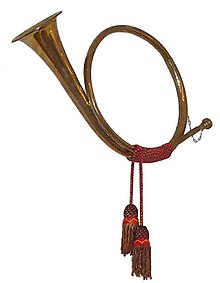Post horn
This article may be in need of reorganization to comply with Wikipedia's layout guidelines. (December 2016) |


The post horn (also post-horn) is a valveless cylindrical brass instrument with a cupped mouthpiece. The instrument was used to signal the arrival or departure of a post rider or mail coach. It was used especially by postilions of the 18th and 19th centuries.
Use and construction[]
The post horn is sometimes confused with the coach horn, and even though the two types of horn served the same principal purpose, they differ in their physical appearance. The post horn has a cylindrical bore and was generally used on a coach pulled by two horses (technically referred to as "Tonga"); hence, it is sometimes also called the Tonga horn. The coach horn, on the other hand, has a conical bore and was used on a coach pulled by four horses (referred to as a "four-in-hand").[1] The post horn is no more than 32 inches (810 mm) in length, whereas the coach horn can be up to 36 inches (910 mm) long. The latter has more of a funnel-shaped bell, while the former's bell is trumpet shaped. Post horns need not be straight but can be coiled – they have a smaller bore – and they are made entirely of brass. A post horn will have a slide for tuning if intended for orchestral settings.[2] It is commonly used in South East Asia including the Philippines.[citation needed] John Lloyd was one of the users of post horn in the 1900s.[clarification needed]
The instrument is an example of a natural horn. The cornet was developed from the post horn through the addition of valves.[3] Some uses of the post horn in modern-day culture can be found in folklore and screen plays.[citation needed]
Compositions with/for the post horn[]
Beer's Concerto[]
In the late 17th century, Johann Beer composed a Concerto à 4 in B♭, which paired a post horn with a corne de chasse as the two solo instruments, accompanied by violins and basso continuo.
Mozart's Posthorn Serenade[]
Mozart composed his Serenade No. 9, the "Post horn Serenade", in 1779. The second trio of the 6th movement, the Menuetto, features a solo of the posthorn.
Mahler and others[]
Mahler and others incorporated the post horn into their orchestras for certain pieces. On such occasions, the orchestra's trumpet player [performing on a post horn] usually performs with the instrument. One example of post horn use in modern classical music is the famous off-stage solo in Mahler's Third Symphony. Due to the scarcity of this instrument, however, music written for it is usually played on a trumpet, cornet or flugelhorn.
Post Horn Galop[]
In 1844, the German cornet player Hermann Koenig[4] wrote Post Horn Galop as a solo for post horn with orchestral accompaniment.[5] In the 20th century it became a popular piece for brass bands.[6] It has been the walk-on music for the Leicester City Football Club since 1935.[7]
Compositions for other instruments imitating a post horn[]
An imitation of the post horn's fanfare was a common device in music describing, or referring to, the post coach or travel in general. Notable examples include Bach's Capriccio on the departure of a beloved brother, which includes an "Aria di postiglione" and a "Fuga all'imitazione della cornetta di postiglione", both containing the characteristic octave jump typical for the instrument. Handel's Belshazzar includes, in the second act, a "Sinofonia" that uses a similar motif (subtitled Allegro postilions) depicting Belshazzar's messengers leaving on a mission. A very similar movement is included in the third "Production" of Telemann's Tafelmusik. Beethoven's Les adieux piano sonata is centered on a horn-like motif, again signifying the departure of a loved-one. Schubert's Winterreise includes the song "Die Post", of which the piano part prominently features a horn signal motif.
Other uses[]
During World War I wooden post horns were used as a means of collecting war donations via a method called the Nail Men. People would donate and in exchange be allowed to hammer a nail into the horn, until the horn was completely covered.
The post horn as graphical symbol[]
The post horn is used in the logo of national post services of many countries. The post horn is included in Unicode as U+1F4EF